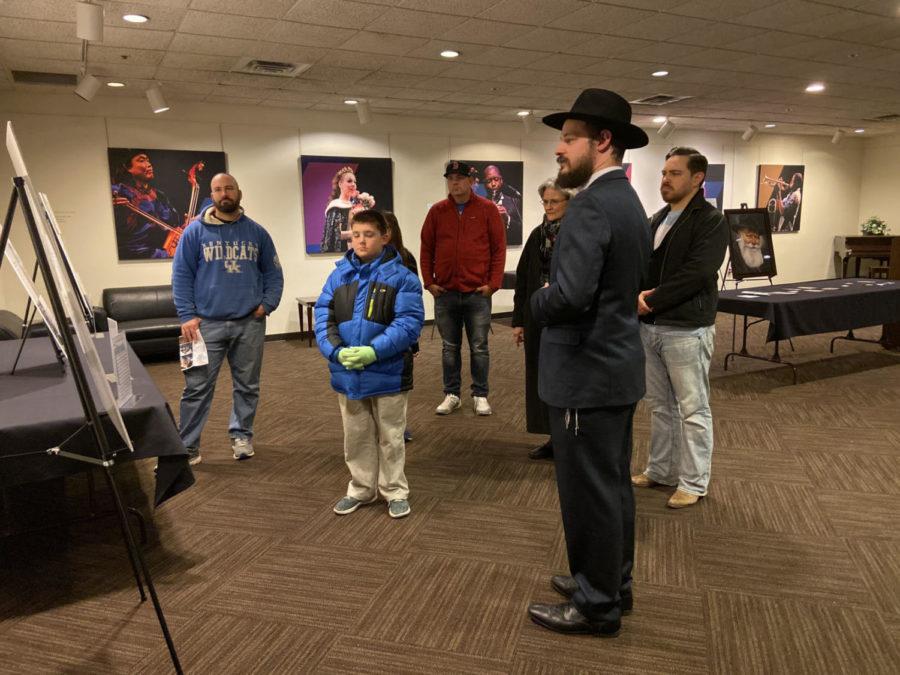On-campus photo exhibit showed the local effects of anti-Semitism
Rabbi Shlomo Litvin explains one of the exhibit pieces to a group who attended the showing of the Contemporary Anti-Semitism exhibit on Tuesday, November 12, 2019 in Lexington, Kentucky. Photo by Natalie Parks | Staff
November 19, 2019
Although art is rarely ever just art, rarely is an exhibit as intentionally instructional as the latest to be shown at UK.
Titled Contemporary Anti-Semitism, the photo exhibit showed at the Singletary Center from November 11-14. Chabad at UK Jewish Student Center paid for the exhibit, which is a collaboration between colleges, to come to UK.
Anti-Semitism is defined as hatred towards Jews, and some studies have reported that anti-Semitism is on the rise in recent years. The exhibit brochure states that “we hope to show the community that anti-Semitism is not linked to one specific people, political party or class. It is a hatred that can and is perpetrated by people across all walks of life in many different forms.”
Abigail Rebenstock, vice president of the UK Jewish Student Center, curated the exhibit as part of her role as program chair. She said the UKJSC had been planning the event for several months.
“The purpose is to provide education about what anti-Semitism is today because it’s changed a lot from the past and it’s important for people to know what images they’re looking at, if they are anti-Semitic,” said Rebenstock.
The exhibit features photo collections organized in eight themes that document the real-life progression of anti-Semitism.
Arranged in a semi-circle to better illustrate this progression, the eight themes include topics like anti-Semitism on college campuses, hatred in Kentucky and rallies of hate.
“Anti-Semitism starts with words and flyers and continues to rallies and movements, but it always ends in violence,” said Rabbi Shlomo Litvin, the director of the UKJSC, during a short speech at the beginning of the exhibit showing on Tuesday, November 13.
Photographs from several incidents in Kentucky are shown in the exhibit, including anti-Semitic flyers at Western Kentucky University, a campaign sign from Robert Ransdell’s write-in Senate bid and a white supremacist rally in Pikesville. The ‘hatred in Kentucky’ portion of the exhibit includes a Kernel photograph from the most recent time the UK Jewish Student Center’s sign was torn down. In total, there have been four instances of anti-Semitism against the UKJSC.
“I think people don’t really think anti-Semitism is a thing anymore, and that’s just really not true,” said Maria Shamai, president of the UKJSC. A senior, Shamai said that “there have been more than a handful of anti-Semitic happenings just on campus and to people I know” and that she hopes the exhibit will improve the campus environment.
As he showed a group around the exhibit, Litvin explained that anti-Semitic flyers made by student groups try to be casual in hopes of flying under the radar, and that anti-Semitic events that happen on campus are usually a collaboration between a student group and an outside group.
Rebenstock hopes that education about anti-Semitism will help keep people from overlooking it when it happens.
In a short statement during the exhibit’s second night, Rebenstock also said “we hope to bring the community together by showing images that have torn apart and rebuilt communities in the not-so-distant past.”
One of those events in the not-so-distant past is the Tree of Life Synagogue shooting in Pittsburgh; the Contemporary Anti-Semitism exhibit showing is just after the one-year anniversary of that massacre.
Rebenstock said that the exhibit is in part a remembrance of that shooting, but “also a way to have something in hopes of preventing something like that from happening again by spreading knowledge and awareness.”
Rabbi Litvin said he does have concerns about anti-Semitism on UK’s campus, saying that there are constant signs of it.
“Extremism concerns us,” said Litvin. “We’re constantly updating security protocols in the Jewish Student Center. UK police just came by just to check what’s going on in the event – most art exhibits don’t get police coming by. it’s a constant thing that we’re aware of, but we also take precautions for it.”
Litvin said that the answer to extremism is “coming together for events. It’s unifying.”
In his opening remarks, Litvin quoted the Lubavitcher Rebbe, who said that there is only one community. Litvin hopes that when we can realize we are all one community, we can end the threat.
“We are very proud to have so many allies across campus who are coming together as one community to oppose hate against us and against anyone and to make sure it never progresses to violence,” said Litvin during his speech.The UKJSC will host more on-campus events in January as part of a Holocaust remembrance week. The week will also coincide with the three-year anniversary of the last time the UKJSC sign was torn down.
Lexington resident Anthony Nunez heard about the exhibit from a friend and came in hopes of learning something.
“I was curious what are all the very anti-Semitic things going on in our culture,” said Nunez, adding that he had read different articles about anti-Semitism without getting the full depth of the issue.
Nunez described the information, and the violence, as shocking. In particular, he said the information about anti-Semitism in the government was “disturbing.”
“I didn’t realize that was going on and that people were so open about their anti-Semitic comments,” said Nunez.
Nunez said he benefited from the exhibit because he is now more informed.
“At least I can be more aware of it, especially if it comes up in some way I can know about it and talk about it,” said Nunez.
“I can at least pay attention, and hopefully be on the side of good.”
































































































































































